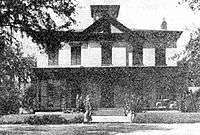Goodwood Plantation
|
Goodwood | |
  | |
| Location | Leon County, Florida |
|---|---|
| Nearest city | Tallahassee |
| Coordinates | 30°27′29″N 84°15′28″W / 30.45806°N 84.25778°WCoordinates: 30°27′29″N 84°15′28″W / 30.45806°N 84.25778°W |
| Architectural style | Georgian |
| NRHP Reference # | 72000334[1] |
| Added to NRHP | June 30, 1972 |
Goodwood Plantation (also known as Old Croom Mansion) was a medium sized cotton plantation of about 1,675 acres (7 km2) in central Leon County, Florida, established by Hardy Bryan Croom. It is located at 1600 Miccosukee Road. The plantation was added to the U.S. National Register of Historic Places on June 30, 1972.
Goodwood Museum & Gardens
The plantation home is now a historic house museum known as Goodwood Museum & Gardens that features original family furniture, porcelain, textiles, glassware, art and personal effects. The rooms have been decorated to appear in the years surrounding World War I. The house is visited by guided tour.
The grounds cover 16 acres (65,000 m2), and the gardens also feature an early 20th-century design. Admission to the gardens is free.
Plantation specifics
The Leon County Florida 1860 Agricultural Census shows that Goodwood Plantation had the following:
- Improved Land: 1050 acres (4 km²)
- Unimproved Land: 625 acres (2½ km²)
- Cash value of plantation: $33,640
- Cash value of farm implements/machinery: $600
- Cash value of farm animals: $3000
- Number of slaves: unknown
- Bushels of corn: 2500
- Bales of cotton: 150

The owners
The Croom family of Lenoir County, North Carolina began purchasing land in North Florida in the 1820s, including plantations in Mariana, Quincy and Tallahassee. Hardy Bryan Croom, a planter and recognized naturalist, discovered the rare Torreya tree. He began amassing the land for Goodwood, purchasing about 640 acres (2.6 km2) of the Lafayette Land Grant in 1833.
On Saturday, October 7, 1837, Hardy Bryan Croom and his immediate family boarded the steam packet liner S.S. Home in New York City bound for Charleston when it sank during the 1837 Racer's Storm. Hardy Bryan Croom and family were killed in the wreck. His brother, Bryan Croom, inherited the property.
Bryan Croom began as owner of Goodwood completed construction of Goodwood in the 1840s. By 1845, Bryan owned 2,500 acres (10 km²) of land in Leon County alone, making him one of the wealthiest men in the territory.


Relatives of Hardy, the Smiths, and his wife Frances fought what became a landmark case all the way to the U.S. Supreme Court. The Smith family was awarded the estate in 1857. It was decided that in all cases where an entire family is destroyed, that the last member of the family assumed alive would inherit, and his heirs would receive the estate. It was assumed that Hardy Croom would have survived the longest and his brother Bryan inherited the majority of the estate including Goodwood, which he finished about 1840. Bryan Croom took some of the furnishings to his new plantation in Montgomery, Alabama, which later served as the Little White House during the Civil War.
Arvah Hopkins purchased Goodwood in 1858. Hopkins was a prominent local merchant who had married Susan Branch, the youngest daughter of former North Carolina Governor John Branch.
In 1885 an Englishman by the name of Dr. William L. Arrowsmith, surgeon-general to the Italian Giuseppe Garibaldi, purchased Goodwood and 160 acres (0.65 km2) surrounding it and brought with him some of the paintings and furnishings still in the house.
In 1911, Mrs. Arrowsmith sold Goodwood to another wealthy widow, Mrs. Alexander Tiers. Fanny Tiers, whose principal estate, Farmlands, was in Morris County, New Jersey, was related by marriage to the Fleischmann family, owners of Waverly Plantation, which was adjacent to Goodwood. Although she spent only limited time at Goodwood, Mrs. Tiers instituted an expansive renovation of the estate and remodeled the house to a Mt Vernon style and replaced the wrought iron with Georgian columns. The Goodwood of today is largely the result of her efforts. Mrs. Tiers then sold the home to Senator William C. Hodges in 1925. Sen. Hodges died in 1940.
In 1948, Margaret Hodges married Thomas M. Hood, an army officer she had met through the rental of the guest cottages at Goodwood. After his wife's death in 1978, Tom Hood began planning for the restoration of Goodwood as a house museum and public park. He established the Margaret E. Wilson Foundation in her memory. Upon his death in 1990, the Wilson Foundation and its operating agent Goodwod Museum and Gardens, Inc. assumed stewardship for Goodwood.
References
- ↑ National Park Service (2010-07-09). "National Register Information System". National Register of Historic Places. National Park Service.
External links
| Wikimedia Commons has media related to Goodwood Plantation. |
- Official website
- Leon County listings at National Register of Historic Places
- Leon County listings at Florida's Office of Cultural and Historical Programs
- Goodwood Plantation History
- Paisley, Clifton (1968). From Cotton to Quail: An Agricultural Chronicle of Leon County, Florida, 1860-1967. Gainesville: University of Florida Press. LCCN 68009708.
- Historic American Buildings Survey (HABS) No. FL-19, "Goodwood Plantation, Tallahassee vicinity, Leon County, FL", 2 photos, 5 measured drawings, 2 data pages, supplemental material
- HABS No. FL-19-A, "Goodwood Plantation, Girl's Cottage", 7 measured drawings
- HABS No. FL-19-B, "Goodwood Plantation, Old Kitchen", 8 measured drawings